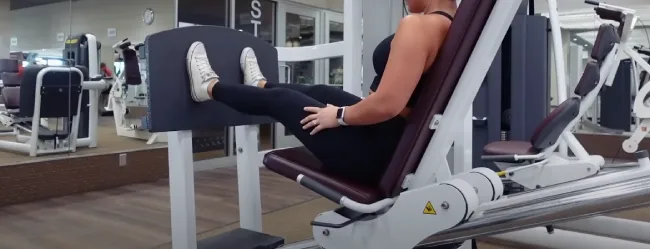Cycling is a fantastic exercise that targets several leg muscles like the quadriceps, hamstrings, glutes, calves, and hip flexors. Cycling is more stamina-oriented, while leg day exercises like squats, lunges, and leg curls offer more resistance and challenge a more comprehensive range of muscles.
Cycling cannot replace a leg day at the gym. Cycling can be an excellent workout for your legs, but whether it can replace leg day depends on your fitness goals. When performed correctly, cycling can engage multiple major leg muscle groups. Better blood flow can improve cardiovascular health.
In this blog post, we’ll explore whether replacing leg day with cycling is possible, the factors to consider when deciding whether to replace leg day with cycling and the cons and pros of cycling instead of leg day.
Can Cycling Replace Leg Day? Pros, Cons & 7 Insights

It’s an excellent form of exercise with several health benefits. Cycling can be a great alternative to traditional leg day workouts for leg exercises. There are pros and cons to completely replacing leg day with cycling.
Whey Protein Power to Support Lean Muscle Mass
Pros of Cycling as a Leg Day Replacement
Cycling can also be an alternative to traditional leg workouts. It is a low-affected exercise that is easy on the joints and has several benefits for your lower body.
- Cycling is an excellent way to build leg muscles, particularly the quadriceps, hamstrings, and calves. The continuous motion of pedaling engages these muscle groups, leading to gradual strengthening.
- Engaging in regular cycling activities can help tone your leg muscles. As you pedal, the muscles in your legs work to propel the bike forward, resulting in improved muscle definition and tone.
- Cycling can help achieve leaner-looking legs. Consistent movement in cycling can help reduce excess fat in the legs, contributing to a slimmer appearance.
- Incorporating cycling into your fitness regimen can effectively target leg fat. As a cardio workout, cycling helps burn calories and fat, which can lead to reduced fat accumulation in the legs.
- Cycling provides a holistic leg workout by engaging various muscle groups in the legs, cycling a good leg workout, offering a well-rounded approach to leg strength and fitness.
- Exercise that reduces the stress on your joints and lowers the risk of injury.
- It can increase your endurance, stamina, and aerobic capacity, enhancing your performance in other exercises and activities.
- It can burn many calories and help you lose or maintain a healthy weight.
- It can tone and strengthen your leg muscles, especially your quads, hamstrings, glutes, and calves.
- Boosts circulation, lowers blood pressure, and prevents heart attacks and stroke.
- It can boost mood, relieve stress, and enhance mental well-being.
- After an intense leg workout, cycling increases blood flow to your legs, delivering oxygen and nutrients to aid in muscle recovery.
Cons of Cycling As a Replacement For Leg Days
Cycling is not a perfect substitute for leg days, and it may have some drawbacks or limitations. Some cons associated with cycling as an alternative to leg day are:
- It may not provide enough resistance or intensity to challenge your leg muscles and stimulate muscle growth and strength.
- It may not target all the muscle groups in your legs, such as your inner and outer thighs, hip flexors, and abductors.
- It may not work out your upper body, core, and back muscles, which are crucial for your posture, balance, and stability.
- It may cause muscle imbalances or overuse injuries if you do not vary your cycling routine or incorporate other exercises.
- External factors, such as the weather, traffic, terrain, and equipment, may affect it, limiting your cycling options or quality.
- Incorporating cycling before a leg workout can affect your overall performance and muscle engagement.
Can Cycling Replace Leg Day: 7 Factors To Consider

If you are considering replacing leg day with cycling, there are a few factors you need to consider to ensure that you are making an informed decision. Below are the seven key aspects to consider when contemplating cycling instead of leg day.
Intensity and Resistance
Consider the level of intensity and resistance involved when replacing leg day with cycling. While cycling is an effective way to increase your heart rate and burn calories, it may provide a different resistance and muscle activation level than a leg day workout . When cycling, your legs primarily work to pedal the bike, which may not challenge your muscles like squats, lunges, and other leg exercises do.
Goals and Objectives
Another critical consideration is your goals and objectives. It’s a great way to stay active and ton your legs to maintain your current fitness and overall health. However, if you want to build muscle mass and strength in your legs, there may be better approaches than replacing leg day with cycling.
Time Commitment
Cycling can be an efficient way to get a good cardio workout, especially if you are short on time. However, it is essential to remember that cycling may provide different overall benefits than a leg day workout, which typically targets multiple muscle groups in your legs. If you have little time but still want a good leg workout, consider combining cycling with a few critical leg exercises.
Injury Risk
Cycling is considered a low-affected exercise, making it an excellent option for individuals at risk of injury or recovering from an injury. However, taking proper precautions and following adequate form when cycling is essential to avoid strain or leg injury.
Varied Routine
Cycling can be a great way to switch things up and mix up your leg-focused workouts. Your workout routine could be beneficial for incorporating cycling to keep your activities exciting and less tedious.
Equipment and Resources
To fully benefit from cycling as a leg workout replacement, it is essential to have access to the proper equipment and resources. This includes a quality bike, adequate cycling shoes, and a safe and comfortable riding environment. You can also feel camaraderie and motivation by joining a cycling group or community.
Personal Preferences
Cycling’s ability to replace leg day depends on personal preferences and individual goals. While some individuals may prefer the resistance and intensity of a leg day workout, others may find that cycling is a more enjoyable and effective way to work out their legs. The key is to listen to your body, set realistic goals, and try different things to find what works best for you.
How to Make the Most of Cycling and Leg Day: 5 Tips

Cycling and leg day benefit your legs and overall health; you do not have to choose one over the other. Put them together to suit your tastes and preferences and get the best of both worlds. Here are some tips on making cycling and leg day work for you:
Tip 1: You should clearly define your goals and objectives for your fitness routine. Think about what you want to achieve.
The plan you have and the dreams you wish to achieve will help you determine how much cycling and leg day you need and how to balance them in your routine.
Tip 2: An evaluation of your current fitness level and your progress so far. You must consider several factors, such as your endurance capacity, strength, and recovery time.
In particular, assess how frequently you do cycling and leg day, the duration and intensity of your sessions, and how you feel after each workout.
Based on your assessment, you can determine the amount of cycling and leg day exercises you can do and adjust them accordingly as you progress.
Tip 3: Variable cycling and leg days are recommended to avoid boredom, burnout, and plateaus. You can mix things up by changing your speed, distance, duration, intensity, resistance, cadence, or terrain for cycling.
On leg day, you have the flexibility to change your exercises, reps, sets, weight, tempo, rest, or order. You can try different cycling and leg day workouts, such as interval, hill, circuit, or plyometric training.
Tip 4: To optimize your cycling and leg day workouts, plan them carefully and strategically. Consider your goals, preferences, availability, energy, and recovery.
Avoid doing cycling and leg day workouts back to back, as this can lead to fatigue, soreness, and injury. Allow at least one rest or recovery between cycling and leg day, or alternate them with other workouts, such as upper body, core, or cardio.
Tip 5: Listen to your body and be flexible. Pay attention to how you feel before, during, and after each session, and adjust accordingly. Be open to trying new things and experimenting with different cycling and leg day combinations.
What works for someone else may not work for you, so find what works for you and enjoy the process. Remember that there’s no universal solution.
Conclusion
The debate on replacing leg day with cycling has been ongoing, and there is no one-size-fits-all answer. It is a matter of preference and fitness goals. While cycling may be a great supplement to leg day and provide a low-affected alternative to those with joint pain, it does not offer enough resistance to replace leg exercises altogether.
For optimal results, a combination of both cycling and leg workouts would be the best approach. Regardless of which route you decide to take, always remember to incorporate precautionary measures to prevent injury and consult your doctor or trainer before beginning a new exercise routine.
FAQs
Can cycling help to prevent muscle soreness from leg day?
While cycling can help increase blood flow and reduce muscle soreness, it may not be enough to prevent soreness from leg day. Incorporating stretching, foam rolling after leg day, and proper nutrition and hydration are essential to prevent and ease muscle soreness.
Is Cycling Considered Leg Day?
Yes. It is an excellent leg workout, especially for your quadriceps and hamstrings. The bicycle will give your glutes and hips a serious workout.
Can I Replace Leg Day With Running?
The activity of running is excellent for improving cardiovascular fitness, but it cannot replace leg day at the gym. It takes a lot of effort and dedication to achieve any results with your legs since they are the largest muscle group in your body.


